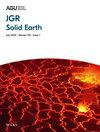结合地球物理和地质多重约束的不确定性量化德国地热热流制图
IF 4.1
2区 地球科学
Q1 GEOCHEMISTRY & GEOPHYSICS
引用次数: 0
摘要
地热热流(GHF)是了解岩石圈热结构和动力学的关键参数,为岩石圈热演化和地热能潜力提供了重要的见解。本研究采用贝叶斯马尔可夫链蒙特卡罗方法估算地壳和地幔热导率、地壳产热和地幔热流等关键热参数,研究了德国GHF的空间变异性。该分析综合了地表热流、地表温度和岩石圈-软流圈边界深度的数据。为了解决直接井眼测量数据的稀疏和不均匀分布所带来的限制(仅包含595个GHF记录),我们纳入了广泛的地球物理和地质限制,如重力、磁力、地震速度、地形以及靠近断层和火山区域。这些数据集使用分位数回归森林方法进行分析,该方法实现了稳健的GHF估计,同时考虑了不确定性并提供了可靠的预测区间。该方法大大改进了传统的基于居里点深度的方法,为德国提供了更准确、更全面的GHF模型。概率多观测方法增强了德国的GHF估计,改善了地热资源和岩石圈热状态的约束。本文章由计算机程序翻译,如有差异,请以英文原文为准。
Geothermal Heat Flow Mapping of Germany Integrating Multi-Geophysical and Geological Constraints With Uncertainty Quantification
Geothermal heat flow (GHF) is a critical parameter for understanding the thermal structure and dynamics of the lithosphere, providing critical insights into lithospheric thermal evolution and geothermal energy potential. This study investigates the spatial variability of GHF in Germany by applying a Bayesian Markov Chain Monte Carlo method to estimate key thermal parameters, including crustal and mantle thermal conductivities, crustal heat production, and mantle heat flow. The analysis integrates data on surface heat flow, surface temperatures, and the lithosphere-asthenosphere boundary depth. To address the limitations posed by the sparse and uneven distribution of direct borehole measurements, comprising only 595 GHF records, we incorporated a wide range of geophysical and geological constraints, such as gravity, magnetics, seismic velocity, topography, and proximity to faults and volcanic regions. These data sets were analyzed using a Quantile Regression Forest approach that enabled robust GHF estimations, while accounting for uncertainties and providing reliable prediction intervals. This methodology significantly improves upon traditional Curie Point Depth-based methods, providing a more accurate and comprehensive GHF model for Germany. The probabilistic multi-observable approach enhances GHF estimates in Germany, improving constraints on geothermal resources and the lithospheric thermal state.
求助全文
通过发布文献求助,成功后即可免费获取论文全文。
去求助
来源期刊

Journal of Geophysical Research: Solid Earth
Earth and Planetary Sciences-Geophysics
CiteScore
7.50
自引率
15.40%
发文量
559
期刊介绍:
The Journal of Geophysical Research: Solid Earth serves as the premier publication for the breadth of solid Earth geophysics including (in alphabetical order): electromagnetic methods; exploration geophysics; geodesy and gravity; geodynamics, rheology, and plate kinematics; geomagnetism and paleomagnetism; hydrogeophysics; Instruments, techniques, and models; solid Earth interactions with the cryosphere, atmosphere, oceans, and climate; marine geology and geophysics; natural and anthropogenic hazards; near surface geophysics; petrology, geochemistry, and mineralogy; planet Earth physics and chemistry; rock mechanics and deformation; seismology; tectonophysics; and volcanology.
JGR: Solid Earth has long distinguished itself as the venue for publication of Research Articles backed solidly by data and as well as presenting theoretical and numerical developments with broad applications. Research Articles published in JGR: Solid Earth have had long-term impacts in their fields.
JGR: Solid Earth provides a venue for special issues and special themes based on conferences, workshops, and community initiatives. JGR: Solid Earth also publishes Commentaries on research and emerging trends in the field; these are commissioned by the editors, and suggestion are welcome.
 求助内容:
求助内容: 应助结果提醒方式:
应助结果提醒方式:


